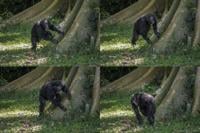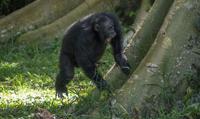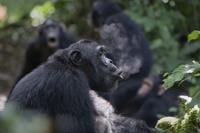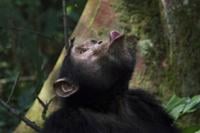In this combination of photos provided by researchers, a wild male chimpanzee drums on a buttress tree while producing a pant-hoot call as he joins his groupmates in the Budongo Forest of Uganda in May 2017. (Adrian Soldati via AP)
In this photo provided by researchers, a wild male chimpanzee drums on a buttress tree while producing a pant-hoot call as he joins his groupmates in the Budongo Forest of Uganda in May 2017. (Adrian Soldati via AP)
In this photo provided by researchers, a wild adult male chimpanzee, the alpha of his community, produces a pant-hoot call early in the morning, as in the background a subadult male, his mother, and younger brother join in with a chorused pant-hoot in the Budongo Forest of Uganda in October 2018. (Adrian Soldati via AP)
In this photo provided by researchers, a wild adult male chimpanzee makes a pant-hoot call while rocking and stomping on a tree as part of a dominance display in the Budongo Forest of Uganda in Februay 2019. (Adrian Soldati via AP)
In this photo provided by researchers, a wild male chimpanzee produces a pant-hoot call to elicit a response from distant group members and reunite with them in the Budongo Forest of Uganda in June 2016. (Adrian Soldati via AP)
A new study shows that chimpanzees drum with regular rhythm when they beat on tree trunks. Previous research has shown that chimps have their own signature drumming style. A new analysis of 371 bouts of chimpanzee drumming demonstrates that the chimps clearly play their instruments -- the tree trunks -- with regular rhythms. This suggests that the ability to produce rhythm predates the last common ancestor of humans and chimpanzees, dating back more than 6 million years. Scientists believe that the drumming is a form of long-distance communication. The research was published Friday in the journal Current Biology.










